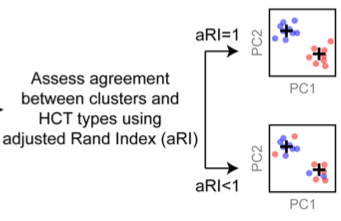Abstract
Graft-versus-host disease (GvHD) remains a major cause for transplant-related mortality in allogeneic hematopoietic cell transplantation (allo-HCT). There is a pressing need for improved approaches for early prediction of GvHD, which may improve survival and quality of life. Since the pathophysiology of GvHD involves immune activation, we hypothesized that immune activation effects on the hypothalamus might lead to alterations in body temperature. To test this hypothesis, we used continuous core temperature monitoring with wireless, implantable sensors to determine whether GvHD is associated with body temperature changes in HCT mice. We observed changes in core temperature in both allo-HCT mice, all of which developed GvHD, and mice who had undergone syngeneic HCT (syn-HCT), none of which developed GvHD. Following transplant, over time both groups experienced hypothermia relative to baseline, with the allo-HCT mice showing severe, cyclical hypothermia at later time points. Using principal component analysis and unsupervised k-means clustering we were able to accurately classify syngeneic vs. allogeneic animals as early as 6 days post-HCT, based purely on core temperature, well before hypothermia became obvious. Our results indicate that continuous body temperature measurement in human allo-HCT patients, potentially using non-invasive wearable sensors, is promising to investigate for early prediction of GvHD.
Key Words: early detection, continuous monitoring, disease biomarker, core body temperature
Main points
-
Unsupervised machine learning analysis of continuous body temperature data revealed early signals of acute GvHD in allogeneic HCT mice.
-
Continuous measurement of body temperature is promising to investigate for early prediction of aGvHD in human allogeneic HCT patients.
